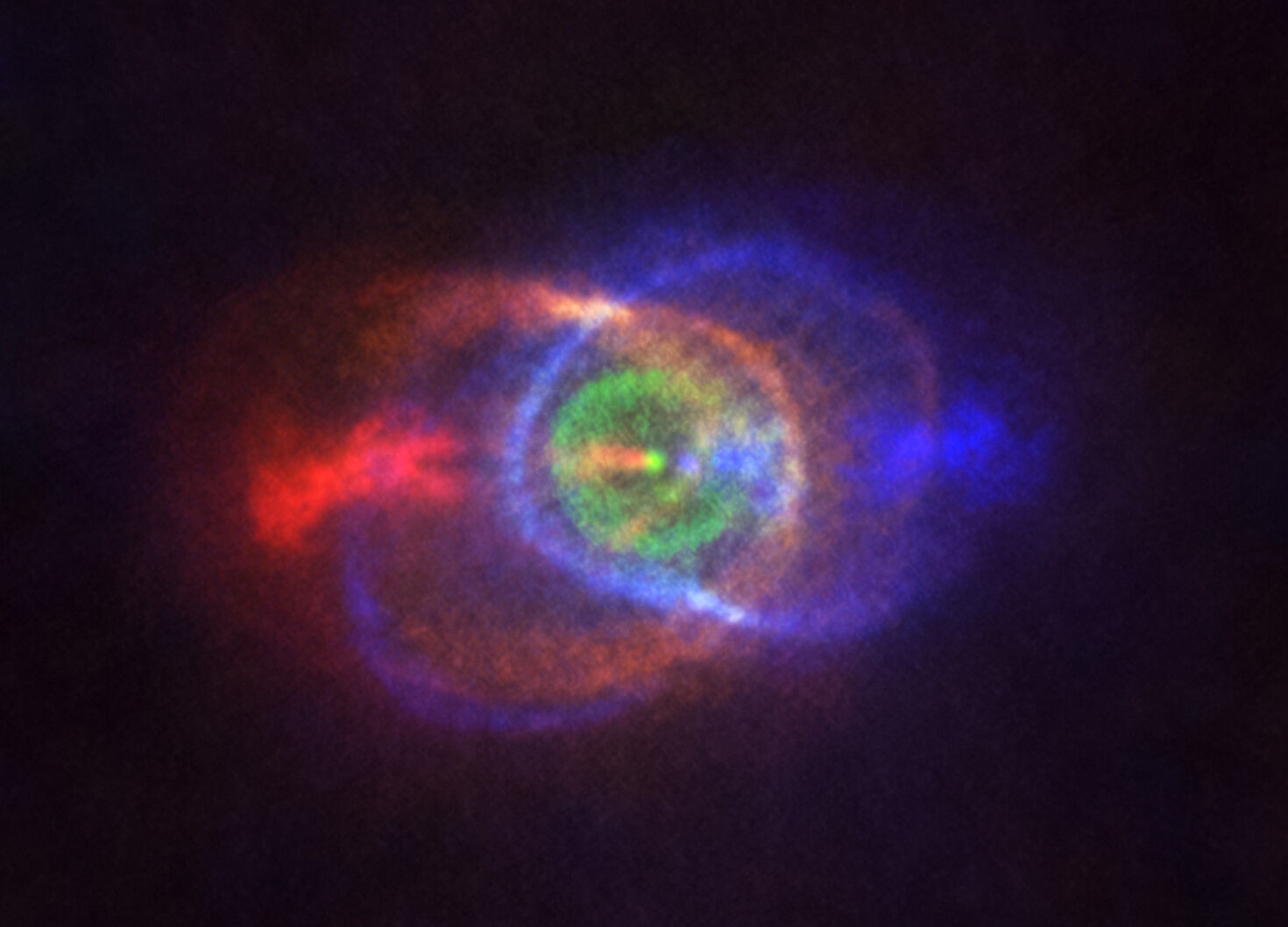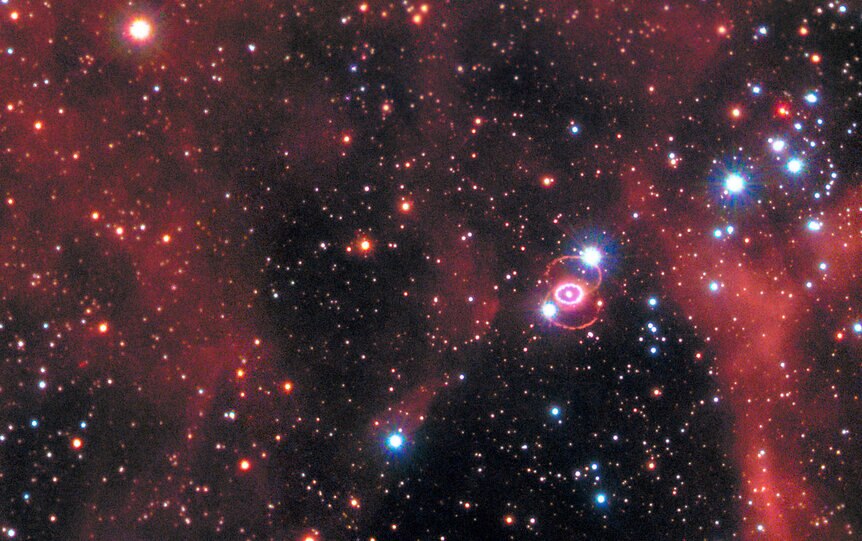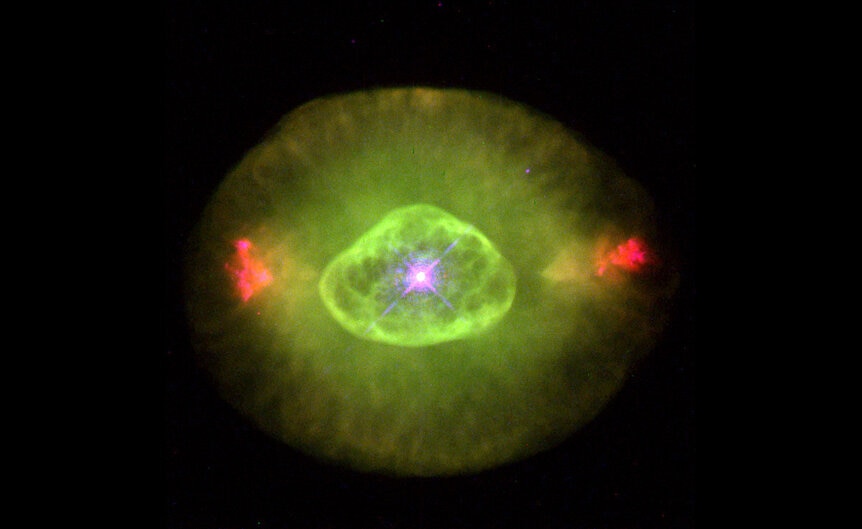Create a free profile to get unlimited access to exclusive videos, sweepstakes, and more!
HD 101584: A binary star casts out a bizarre hourglass of gas

Give Nature a chance, and it'll make some truly weird stuff.
It's already pretty peculiar that stars change so much over their lifetimes. Take a star like the Sun. Let it age for, oh, 12 billion years, and it goes from being a rather compact million-kilometer-wide hot ball of plasma to becoming an immense 300-million-kilometer-wide giant, so huge that its density drops to almost a vacuum at its surface and the temperature drops by a factor of two, changing its hue to red.
The gravity at its surface is so much lower (due to the size) that an atom of gas sitting there feels much less of a pull downward. But at the same time, the fierce energy radiating from below it imparts a force outward that's stronger than gravity. The gas gets blown away. This process actually removes most of the star's outer layers, which flow away, leaving behind the star's core, a dinky but very hot white dwarf.
I mean, c'mon. That's so weird!
Now add a companion star, a second star to create a binary system. Then things get really strange.
How strange? This strange:
That's HD 101584. Well, the star in the center (the green dot) is HD 101584. The rest of that is gas and dust blown out by the system, creating bizarre arcs and hourglass shapes and swooshes* and jets of material flowing away.
What could cause all this structure? Well, that's the fun bit: It's not totally clear.
This observation is from ALMA, the Atacama Large Millimeter/submillimeter array. Located in the Atacama desert in Chile, it uses a series of dishes to observe light far outside what our eyes can see, just this side of being radio waves. This makes it sensitive to things like dust (grains of rocky and/or carbonaceous material) and cold molecular gas.
ALMA detected over a dozen different molecules in the gas, but the image is made specifically from carbon monoxide (or CO). The colors represent velocities: Blue is material headed toward us, red away, and green neither toward nor away from us (it still might be moving, but perpendicular to our line of sight, so there's no Doppler shift to the light). That's not the actual color of the gas; it's meant to represent speed and direction of the gas.
The structure outlined is getting to be a familiar one to astronomers: An hourglass shape with a dense disk or ring of material around the waist, similar to that seen around Supernova 1987A. This is almost certainly due to interactions with a companion star.
Left by itself, a red giant will blow a spherical wind, ejecting its outer layers in an ever-expanding sphere. However, if there's a second star, and it's close enough to the first star, then weird things happen. The red giant can expand so much that it envelopes its companion; the second star is actually inside the red giant. The outer layers of the first star are much less dense when they expand, so the second star orbits inside this thin soup.
As it does, several things can happen that alter the way the red giant blows of material. For one thing, the second star's orbital motion is changed; it's plowing through the gas, robbing it of orbital energy. It starts to slowly fall toward the center of the red giant. But the converse of this is that it's giving its orbital energy to that gas, so that gas gets more energy and blows away more easily.
Most of the gas blows away in the equatorial plane of the two stars' mutual orbit. That's just playground physics. Literally! If you've ever been on one of those spinny disk things with handles on it you're familiar with centrifugal force (or centripetal acceleration, depending on what frame of reference you choose). It feels like there's a force pushing you away from the center of the disk along its surface as it spins. It's the same with the stars; as they orbit around each other gas will tend to get flung away from the center of their orbit in the plane of their orbit.
That creates a dense disk of material around both stars (called a circumbinary disk). But stuff above and below the stars' orbital plane still feels a force outward due to all the energy generated inside the star, so that material blows off as well, up and down, creating two large lobes that form the hourglass shape. As it happens, we see the orbit of these stars nearly face-on (note the green circumbinary disk is nearly circular; if we saw this system at an angle it would be more elliptical), so one lobe is expanding toward us (the one colored blue) and one away (the red one).
Things get complicated after this. The distance to the star system isn't well known, and a lot of what we see depends on how far away it is. For example, the size of the structure isn't clear. That makes it hard to know how much energy the gas has as it expands. That energy comes from the second star spiraling in, which in turn depends on the masses of the two stars. They may be close to us and lower mass, or farther from us and higher mass.
Some subtle effects indicate the system is closer and the stars masses lower. For example, the isotope ratios of oxygen seen in the gas is more compatible with what you expect to be created by a lower mass star, one with less than the mass of the Sun, making the system closer. The authors of the research do lean towards this conclusion.
Interestingly, the amount of energy they calculated that can be extracted from the second star spiraling in is a factor of ten too low to explain the gas ejected! A second source of energy must be hiding in there. They suggest that material from the red giant is falling onto the second star, creating a disk around it, and that releases enough energy to explain things. Interestingly, although it's not in the big overall image, there's evidence of material moving away that doesn't align well with the rest of the structure. The authors suggest this could be material blowing away from the second star. It's not certain, but the idea does explain much of what's seen.
As strange as all this is, it's not rare. There are billions of stars in the galaxy like our Sun, ones capable of turning into red giants when they die and blowing off gas, forming what we call planetary nebulae. And perhaps half of all stars are in binaries. Planetary nebulae come in all kinds of shapes, some similar to HD 101584, possibly due to their star's binarity. The Sun itself isn't a binary, so it won't look like this but it may very well become a planetary nebula in, oh, six or seven billion more years.
So, weird? Yeah. But what does it mean to be weird if lots of other things are weird too, especially in the same way?
The whole Universe is weird. We can learn a lot about binary stars and stellar end states from HD 101584, but maybe just being reminded of that cosmic weirdness is a good lesson, too.
*This may not be a technical term, but it speaks for itself.

















